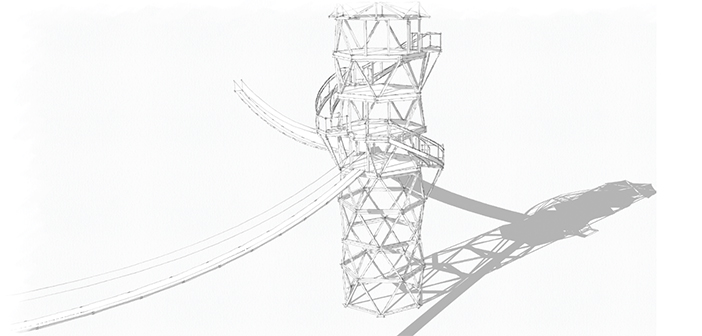In the spring of 2020, uncertainty shrouded the landscape. Many of us were apprehensive about what the immediate future would look like. There were more questions than answers. Would adventure parks and challenge courses be able to open? Could installation projects move forward? Despite the uncertainty, committed operators and builders pressed on. As a result, several new or expanded parks opened, with other openings and expansions extending into the 2021 season.
While some of these projects were planned before the pandemic struck, others were inspired by the interests of new guests who were lured into the outdoors as they sought to escape their homes amid Covid-19 restrictions. Together, these projects highlight several trends in park visitation and design. They provide food for thought for the broad spectrum of adventure operators and programs.
THE FORGE: LEMONT QUARRIES
Builder: Bonsai Design
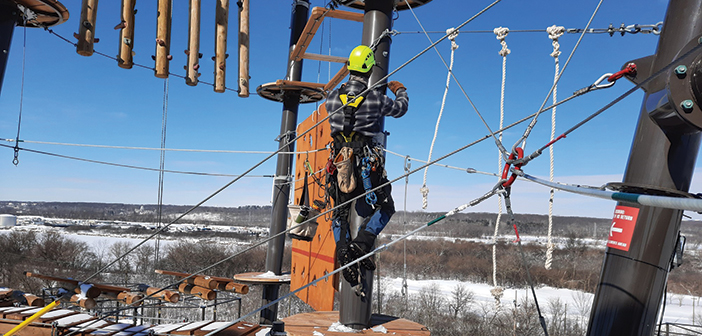
The Bonsai team worked through the winter to make additions and modifications to The Forge: Lemont Quarries, Ill., which opened in summer 2020. Rendering: ERi.
The Forge: Lemont Quarries, Ill., a multi-activity park built on an abandoned dolomite limestone quarry, celebrated its grand opening in July 2020, just in time to enjoy the challenges of operating in the middle of a pandemic. The extensive aerial adventures were designed and constructed by Bonsai Design.
The aerial installation is based around eight adventure towers—five hex towers, two “X” towers, and the Skyscraper Tower, inspired by the Chicago skyline. In all, The Forge is home to nearly 300 challenge elements, climbing walls, and rappel devices, plus dual-racing zip lines between two of the towers over the quarry pond.
After operating the park for six months, The Forge noticed several trends in the programmatic flow of the course. “We wanted to give guests with different abilities more choice about how they experience the course,” says The Forge co-founder and CEO Jeremie Bacon. So Bonsai came up with “modifications that could enhance throughput potential throughout the site,” says Bonsai’s John Nixon.
The Bonsai team worked through the winter to make additions to the course, including the addition of TruBlue free fall devices to create additional (and thrilling) options for guests to exit the course. Bonsai also installed ladders as entry points to the different challenge course nodes. According to Bacon, this improves staffing efficiency, as it allows staff to access different activities on the course quickly from the ground, rather than requiring them to be positioned throughout the course at-height to allow for quick response times.
Additionally, guests showed a strong interest in participating in the zip line as a standalone activity. To satisfy this interest and create a new revenue source, Bonsai installed a ladder that provides direct access to the zip line launch on the East X tower. The ladder allows for up to four participants at a time to ascend on a wire rope cable grab system and access the zip line.
“The course was designed to be modular, so that based on demand, market need, and technological advancements, we are always able to add more,” says Bacon. “This gives us more flexibility in terms of the products and experiences we can offer our guests.”
SKYLIFT PARK LOOKOUT TOWER
Builder: ERi
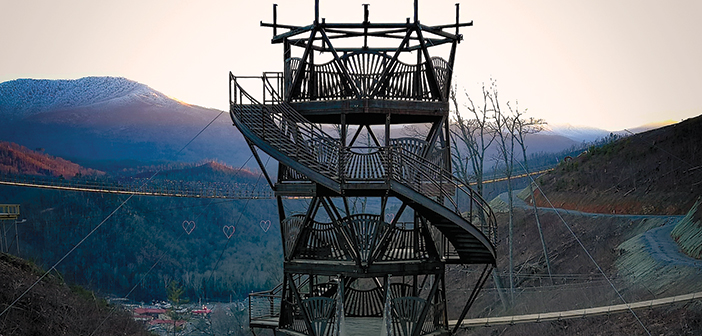
The Lookout tower at SkyLift Park in Gatlinburg, Tenn., prior to installation of the roof. The tower is a key element of the park’s new SkyTrail scenic walkway. Background renderings: Bonsai Design.
The Gatlinburg SkyLift Park originally opened in 1954, with a scenic chairlift taking guests up a mountainside above the town of Gatlinburg, Tenn. The park was renovated and expanded in 2019, and celebrated the grand opening of the SkyBridge, a 680-foot-long simple suspension bridge that is 140 feet above the valley below. The scenic chairlift ride from downtown Gatlinburg brings guests up to the SkyDeck, a viewing deck with outdoor seating and firepit, and restaurant at the adjacent SkyCenter building.
Designed and built by Experiential Resources Inc. (ERi), the SkyBridge was part of phase one. Phase two, scheduled to open in spring 2021, is the SkyTrail scenic walkway. The SkyTrail consists of three sections: the Boardwalk, an elevated wooden walkway; the Pathway, a smooth walking path cut into the hillside; and the Lookout, a 72-foot-tall steel structure providing views of the SkyBridge and valley below.
Fabrication of the Lookout’s A588 weathering steel frame began in August 2020, with the foundation poured in November, and the structure and stairs “erected in one, very long crane day on the first of December,” says ERi CEO Mandy Stewart.
The SkyTrail makes both ends of the SkyBridge accessible by walking trail, allowing guests to enjoy more of the property. The Boardwalk connects to the tower via two suspension bridges, where guests can climb the curved staircase to access the three upper decks of the tower. The team at ERi angled the staircase railings out “to give guests the opportunity to experience the thrill of being up in the air and out in the open while being held securely on the Lookout—no special equipment required,” says Stewart.
The Lookout tower wasn’t part of the original plan. The project, as conceived in 2015, included a tree-based canopy walk. However, wildfires in 2016 severely damaged trees on the SkyLift Park property, making the tree-based plan moot. ERi re-worked the concept and developed plans for the Lookout tower, which is placed on the site of a tulip poplar tree that was well-loved by the SkyLift team prior to the fires.
MOSHOLU DAY CAMP KOALA COURSE
Builder: Tree-Mendous
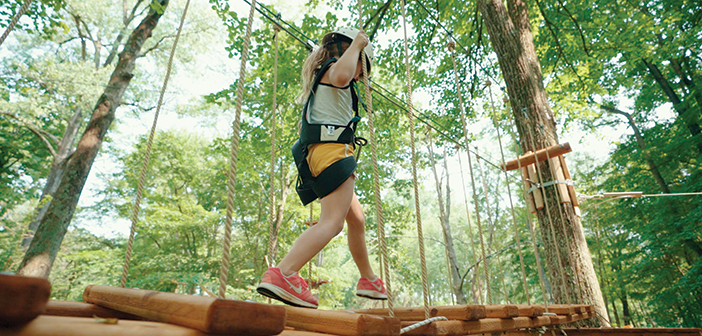
A child navigates a Koala Course built by Tree-Mendous, this one at Barton Orchards in N.Y
When campers return to Mosholu Day Camp on the shores of Lake Cohasset in New York this year, they’ll be greeted by a new adventure. Tree-Mendous is scheduled to begin construction on the Koala aerial trekking course in early spring 2021, with a completion date prior to the start of the summer 2021 camp season.
Mosholu Day Camp provides a nature-based experience for underprivileged children ages 5-16, primarily from urban environments. “A lot of these kids haven’t had the opportunity to experience the outdoors,” says Tree-Mendous CEO Gerhard Komenda.
The Koala Course, a Tree-Mendous product, is typically designed for children ages 3-10 and placed 3-4 feet off the ground. For the Mosholu installation, it was modified to suit a broader range of participants. Though still primarily intended for younger campers, the team wanted an adventure activity that campers of all ages would enjoy. Therefore, the Koala Course will feature seven elements set 7-8 feet off the ground, finishing in a zip-to-ground element. A Koala continuous belay system will keep campers connected through the entire course.
The seven-element layout is only stage one. Komenda and his team have designed the course to allow for expansion so that the activity can evolve along with the camp.
GERONIMO ADVENTURE PARK
Builder: Challenge Towers
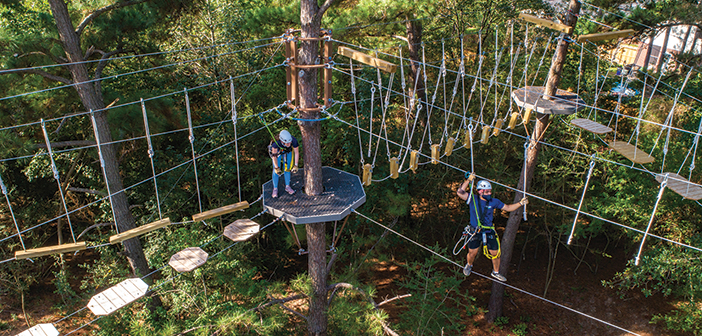
The Challenge Towers team tests the features at the Geronimo Adventure Park in Spring, Texas, which opened in fall 2020.
Geronimo Adventure Park in Spring, Texas, celebrated its grand opening in October 2020. The adventure park was constructed on an eight-acre property and offers a wide variety of activities for its guests. Located about 30 minutes north of Houston, the adventure park hopes to draw guests from around the greater Houston area to enjoy the outdoors.
In addition to axe throwing, human bumper balls, fire pits, and ground-based family activities, the cornerstone attractions are its zip lines and aerial adventure course. Designed and built by Challenge Towers, the hybrid design utilizes both poles and trees outfitted with the company’s Skylark platforms, which are specially designed to allow for elements to be connected directly to the platform frame, rather than above or below the deck, eliminating step-downs and trip hazards.
The course also includes custom-fabricated belay hubs where multiple elements converge at a platform and guests can easily and cleanly navigate through the various courses. The park’s three Skytrail courses—one easy, one high, and one long—feature zip lines and aerial adventure elements ranging in difficulty from novice to advanced. The long course ends with a 555-foot tandem mega zip, while the high course concludes with a Powerfan free fall to add more adrenaline to the adventure. Guests who prefer a more gentle descent can choose a slower rappel.
TAOS SKI VALLEY VIA FERRATA
Builder: Adventure Partners
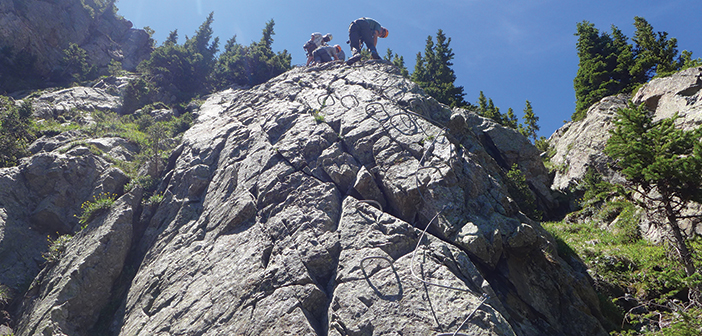
The Adventure Partners team set rungs for the Taos Ski Valley Via Ferrata in New Mexico.
In August 2020, Taos Ski Valley, N.M., opened its brand-new via ferrata, designed and built by Adventure Partners. Via ferrata, Italian for “iron way,” is an assisted rock-climbing route utilizing fixed cables, rungs, and suspension bridges to assist climbers with scaling steep, rocky terrain. The Taos installation allows climbers to ascend the sub-alpine ecosystem of Kachina Peak, situated at 11,500 feet above sea level in Carson National Forest.
Adventure Partners worked with the Taos Ski Valley team to design and install three tours for novice through advanced challenges, featuring via ferrata routes up some of the more iconic rock faces of Kachina Peak, along with a double cable catwalk and a 100-foot sky bridge suspended 50 feet in the air. The route uses about 1,000 feet of cable strung through 417 rungs set into the pre-Cambrian granite.
The installation is part of a larger plan to attract year-round visitation to the ski area. This type of development was often discouraged by the Forest Service prior to passage of the Ski Area Recreational Opportunity Enhancement Act of 2011, which allowed resorts operating on national forest land to pursue summer activity installations.
ADIRONDACK EXTREME LOW RIDER ZIP TOUR
Builder: Outplay Adventures
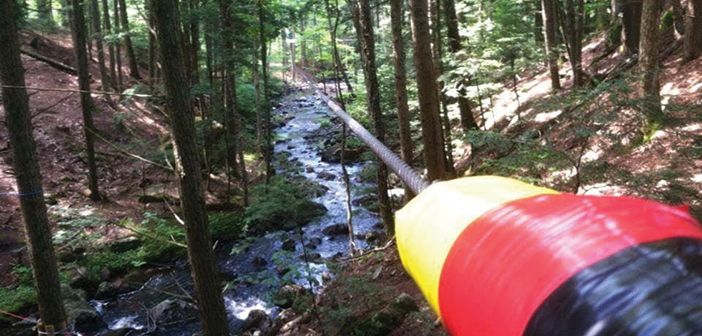
A view down a zip on the new Low Rider tour at Adirondack Extreme.
Adirondack Extreme Adventure Course was originally designed and constructed in 1997, making it one of the very first aerial trekking courses in North America. The park has slowly been growing its aerial adventure offerings ever since. This year is no different: As of press time, Outplay Adventures, the build company owned by Adirondack Extreme founder Dave Johnson, was putting the finishing touches on a brand-new zip line course for Adirondack Extreme, the “Low Rider Zip Tour.”
The Low Rider tour is designed for first-time, novice zip line adventurers. The course will consist of 14 zip lines and seven bridges. “The difference between our [Low Rider] course and other traditional zip tours is its proximity to the ground,” says Adirondack Extreme owner Jamie Johnson, who purchased the park from his father, Dave. Each of the zip lines for the Low Rider tour will be no more than 25 feet off the ground.
With zip lines ranging from 75 to 200 feet in length, he adds, the Low Rider tour “quenches your thirst for adventure without the threat of being too far off the ground.” The tour will be available as a standalone adventure or as an add-on activity for guests partaking in the park’s eight other aerial courses.
“There’s nothing like the thrill of a treetop experience to reconnect and foster the togetherness we now hold so valuable,” says Dave Johnson.
Are you building? Do you have exciting things in the works? Keep us in the loop! Email [email protected] and tell us what you have going on.


